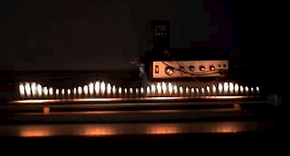Rubens' tube

A Rubens' tube, also known as a standing wave flame tube, or simply flame tube, is an antique physics apparatus for demonstrating acoustic standing waves in a tube. Invented by German physicist Heinrich Rubens in 1905, it graphically shows the relationship between sound waves and sound pressure, like a primitive oscilloscope. Today it is only used occasionally, as a demonstration in physics education.
Overview
A length of pipe is perforated along the top and sealed at both ends - one seal is attached to a small speaker or frequency generator, the other to a supply of a flammable gas (propane tank). The pipe is filled with the gas, and the gas leaking from the perforations is lit. If a suitable constant frequency is used, a standing wave can form within the tube. When the speaker is turned on, the standing wave will create points with oscillating (higher and lower) pressure and points with constant pressure (pressure nodes) along the tube. Where there is oscillating pressure due to the sound waves, less gas will escape from the perforations in the tube, and the flames will be lower at those points. At the pressure nodes, the flames are higher. At the end of the tube gas molecule velocity is zero and oscillating pressure is maximal, thus low flames are observed. It is possible to determine the wavelength from the flame minimum and maximum by simply measuring with a ruler.
Explanation
Since the time averaged pressure is equal at all points of the tube, it is not straightforward to explain the different flame heights. The flame height is proportional to the gas flow as shown in the figure. Based on Bernoulli's principle, the gas flow is proportional to the square root of the pressure difference between the inside and outside of the tube. This is shown in the figure for a tube without standing sound wave. Based on this argument, the flame height depends non-linearly on the local, time-dependent pressure. The time average of the flow is reduced at the points with oscillating pressure and thus flames are lower.[1]


History
Heinrich Rubens was a German physicist born in 1865. Though he allegedly worked with better remembered physicists such as Max Planck at the University of Berlin on some of the ground work for quantum physicists, he is best known for his flame tube, which was demonstrated in 1905.
This original Rubens' Tube was a four meter section of pipe with 200 holes spaced evenly along its length. When the ends are sealed and a flammable gas is pumped into the device the building pressure will have only one route to equalize. The escaping gas can be lit to form a row of roughly even flames. Upon introduction of a loud speaker to one of the sealed ends, standing waveforms can be seen in the flames.
Within the Rubens' tube, as soon as gas is ignited generally uniform flames will be seen. This is because there is very little pressure differential between any given area of the space inside the tube. Once sound is applied from one end, pressure will change within the tube. Should the sound be an easily measurable frequency, the wavelength will be visible in the series of flames, with the highest flames being where compression is occurring and the lowest where rarefaction is occurring.
Public displays
A Rubens' Tube was on display at The Exploratory in Bristol, England until it closed in 1999. A similar exhibit using polystyrene beads instead of flames featured in the At-Bristol science centre until 2009.[2]
This display is also found in Physics departments at a number of Universities.[3] A number of physics shows also have one, such as: Rino Foundation [4] (The Netherlands), Fysikshow Aarhus (Denmark), Fizika Ekspres (Croatia) and ÅA Physics show (Finland).[5][6]
The Mythbusters also included a demonstration on their "Voice Flame Extinguisher" episode in 2007.[7] The Daily Planet's The Greatest Show Ever,[8] ran a competition whereby five Canadian Science Centres competed for the best science centre's experiment/display. Edmonton's Science Centre (Telus World of Science) utilized a Rubens' Tube. In fact, the Rubens' Tube won the competition. The special was filmed on October 10, 2010.
The artist Emer O'Brien used Rubens tubes as the basis for the sound sculpture featured in her 2012 exhibition Return to Normal at The Wapping Project in London. [9]
References
- ↑ G.W. Ficken, F.C. Stephenson, Rubens flame-tube demonstration, The Physics Teacher, Vol. 17, pp. 306-310 (1979)
- ↑ "The Exploratory - Exhibits". Retrieved November 6, 2006.
- ↑ "Oscillation & Waves". Retrieved November 8, 2006.
- ↑ "website Rino Foundation". Retrieved October 29, 2009.
- ↑ "Fizika Ekspres website". Retrieved April 20, 2009.
- ↑ "ÅA website". Retrieved April 20, 2009.
- ↑ "Discovery Channel Video". Retrieved August 11, 2009.
- ↑ "Daily Planet's The Greatest Show Ever". Retrieved October 10, 2010.
- ↑ "Emer O'Brien - Return to Normal". re-title. Retrieved January 1, 2014.
External links
| Wikimedia Commons has media related to Rubens' Tube. |
- Baroque hoedown for 6 Ruben's tubes by Mathew Kneenone and Yuri Suzuki
- Detailed Video including sound board and microphone
- Experiment notes, video & detailed analysis
- Flame tube setup and explanation of effects
- Brief Setup Guide
- Classroom setup guide
- Information on Rubens' original design in .doc format
- Image showing setup
- General information
- Experiment setup - under "Links" heading and photo illustrating this experiment
- Video various tones and music being played
- Rubens' Tube performance by Alyce Santoro